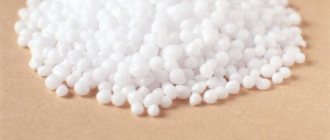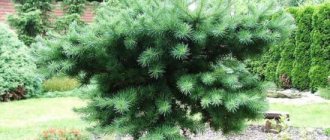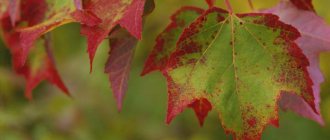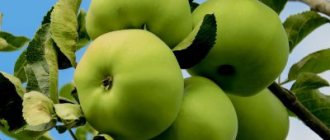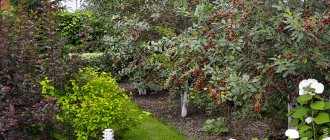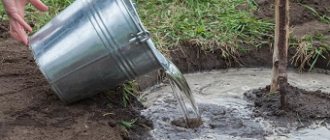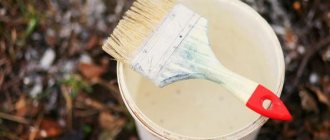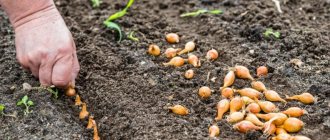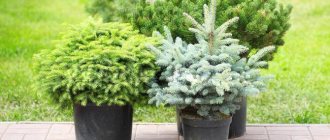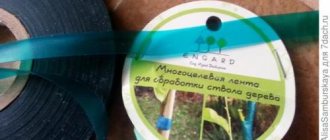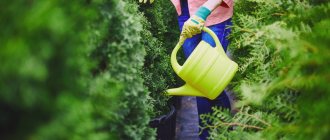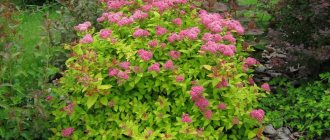Which trees shed their leaves for the winter?
- chestnut;
- poplar (begins to shed leaves at the end of September);
- Linden;
- elm;
- bird cherry;
- birch;
- oak (leaf fall begins in early September);
- rowan (loses leaves in October);
- apple tree (one of the last fruit crops to shed its leaves - in early October);
- nut;
- maple (can stand with leaves until frost);
- willow.
Only coniferous plants remain green throughout the winter. With a short summer, living conditions for the regeneration of leaves every year are extremely unfavorable. That is why there are more evergreen species in the northern regions.
Did you know? In fact, coniferous plants also shed needles. Only they do this not annually, but once every 2-4 years, gradually.
Summary of a lesson in a preparatory group for school, topic: “Do all trees shed their leaves?”
Program content:
1. To form children’s ideas about the adaptation of trees to different climatic growing conditions: southern, northern, to the conditions of hot countries, jungles. 2. To consolidate and expand children’s knowledge about “coniferous”, “deciduous” and “evergreen” trees. 3. Lexical work: – exercise children in forming adjectives from nouns; – in agreement of numerals with nouns. 4. To instill in children a caring attitude towards nature and develop interest in it.
Material:
Reasons why leaves don't fall
Foliage that has not fallen in autumn indicates that the tree’s growth stage is incomplete. This is typical for most cultures of southern or Western European origin. They are not adapted to short-term summers and require a long and warm growing season. However, even winter-hardy crops can remain with green foliage over the winter. Check out the Top 15 deciduous trees and shrubs for your garden.
This situation may arise in the following cases:
- There has been a glut of nitrogen-containing fertilizers. They stimulate the growth process.
- The dry summer gave way abruptly to a rainy, cold autumn. Moreover, frequent watering only aggravates the situation.
- The climate is not suitable for this variety. Perhaps the plant did not have time to completely complete the development phase.
- Incorrect trimming. If this work is done incorrectly and at the wrong time, it can provoke the rapid development of new shoots and leaves.
As a rule, all these factors lead to the fact that the plant enters wintering exhausted, with underdeveloped shoots and with delayed leaf fall. In addition, pathogens of various diseases remain in the leaves, which leads to consequences such as frostbite or burns of fragile branches.
Important! Diseased foliage negatively affects the condition of the entire plant, weakens yield and reduces resistance to pests.
Why don't trees shed their leaves?
As mentioned above, leaf fall is a natural phase of a plant’s life, which indicates that it has finished vegetating and has prepared for hibernation. If this does not happen, then this means only one thing: the tree continues to grow and actively absorb nutrients. What could lead to such a situation?
Unsuitable variety. Often, a plant is in no hurry to shed its leaves because the selected variety is not suitable for growing in specific climatic conditions. In other words, the tree does not have time to prepare for hibernation due to the fact that the “biological program” embedded in it is designed for a longer growing season. That is why it is very important to plant only zoned varieties of trees and shrubs on the site.
Overfeeding with nitrogen . As you know, nitrogen promotes the active growth of green mass, so if you want the plant not to start growing by leaps and bounds at the most inopportune moment, it is very important to follow the garden fertilizing schedule, paying especially close attention to the issue of autumn fertilization.
- Autumn fertilizers - how to feed the garden, vegetable garden and flower garden at the end of the season
We'll tell you how to enrich the soil so that green pets will continue to delight you next year.
Excess moisture. As you remember, one of the most important functions of foliage is transpiration, i.e. liquid level control. Accordingly, if a rainy autumn comes after a dry summer, the leaves will not be able to quickly adapt to new conditions and will no longer cope with the load placed on them. The tree will experience an excess of moisture and will not shed the “organ” that is so necessary at the moment. In principle, this situation can happen to any tree if you do not follow the rules for late watering of the garden.
- Moisture-charging irrigation in autumn: water standards for trees and shrubs
How to properly “charge” trees with water in the fall so that they survive the winter safely?
Too radical summer pruning. It is believed that summer pruning has a beneficial effect on the condition of young fruit trees. Firstly, it speeds up the process of crown formation, and secondly, it helps to bring fruiting closer. However, such pruning should be carried out taking into account the characteristics of each specific tree. If you prune too much, the tree, deprived of the required amount of foliage, will begin to hastily grow new shoots, which will extend its growing season indefinitely. A similar statement is true for ornamental trees and shrubs.
- How to prune fruit trees in summer - 5 simple and effective techniques
An experienced specialist explains why trees need pruning in summer and how to do it correctly.
Weather anomalies. Too warm autumn weather, which in recent years has often been established in one or another region of the middle zone, often leads to the fact that the plant does not receive signals from the outside about the imminent approach of winter and continues to grow. However, no matter how long autumn may seem, it will not last forever, which means that by the time frost hits, the tree will not be prepared for it.
The lack of leaf fall is not a reason, but one of the signs that the tree has not had time to prepare for winter.
How to help and what to do
Specialists and experienced gardeners know that even trees unprepared for winter can be helped. First of all, it is necessary to develop resistance to frost. To do this you need:
In early spring, plants that have stood with leaves on the branches all winter will need to be fed with potassium sulfate, and in the summer, the crown will need to be sprayed with a pink solution of potassium permanganate. Thus, the process of preparing trees should begin in advance so that they do not stray from the circuit established by nature. Only in this case will the tree meet the frosts strong and give a good harvest the next season.
Eradication treatment of the garden
The issue of timely leaf fall worries many summer residents also because it is this process that serves as a signal for eradicating the garden. What to do in a situation when the time seemed to have come, but the tree did not have time to part with its foliage? There is no clear answer to this question. Some gardeners believe that such treatment can be carried out even if the plant has not had time to shed its leaves, since the leaves have already fulfilled their functions, and therefore this procedure will not cause much harm. Others are inclined to believe that by treating a tree whose growing season has not yet completed with chemicals, you can inadvertently burn the buds that have not yet closed.
In any case, the choice will be yours, so before you begin this procedure, weigh all the risks and carefully study the rules for eradicating the garden.
No matter how well we understand the risks that result from unprepared trees for winter, we are unable to speed up this process at the end of autumn. Even if you manage to mechanically remove leaves from all the trees, you are unlikely to be able to do this without damaging the place where the petiole joins the branch, and a large number of small wounds will only aggravate the situation and increase the risk of frostbite.
Source
The apple tree did not shed its leaves in the fall, what to do?
Autumn is the time when many trees shed their leaves. Some earlier, others later. The apple tree is no exception. However, both our columns and the neighbor’s full-sized apple tree left for the winter with leaves last year. Even with the arrival of spring, many withered leaves still remained on the branches.
Read on Dacha6.ru:
Let's try to figure out why this happens, whether this is the norm or a dangerous signal.
Why do we need leaf fall?
As autumn colds arrive, the leaves of deciduous trees change color mainly from green to yellow. This occurs due to the destruction of chlorophyll due to reduced daylight hours, lower temperatures, and lack of moisture. Nutrients and moisture gradually leave the spent leaf.
Read also: Quinoa is a disaster for crops, or how to deal with quinoa
At the end of leaf fall, the tree falls into a deep sleep, which will last until spring.
If the apple tree on your site has shed its leaves in a timely manner, it means that active growth processes have slowed down, the bark has fully matured and is ready to protect the tree from frost.
If the leaves do not fall at the appointed time, then picking them yourself is absolutely useless. It is necessary to act differently.
What to do if trees don't shed leaves
First, you need to determine the extent of the problem. If the leaves on the trees have turned yellow, but have not yet flown off, then it is likely that they will do so in the very near future, so there is no need to worry about this.
If the foliage has not had time to change its color even in late autumn, carry out an additional check to see if the plant is prepared for hibernation. Gently grab one of the branches with your fingers and move your hand from the trunk to its tip. If the leaves come off easily, this means that a plug has formed on the petioles and nutrients are no longer supplied to the leaf blades, i.e. the leaf growing process has come to an end. Accordingly, there is no need to raise any particular alarm about this.
Secondly, it is worth understanding the reason for such uncharacteristic behavior of trees. If the leaves have not fallen on one tree, then most likely the plant has suffered due to excess nitrogen, improper pruning, or waterlogging. In this case, you will have to analyze the tree care calendar and work on mistakes so that the situation does not repeat itself next year.
If the trees do not shed leaves en masse, i.e. A similar problem is observed not only in yours, but also in neighboring areas, which means that the lack of leaf fall was caused by a natural anomaly, which you would not have been able to influence in any case.
So, you observed the trees and came to the conclusion that they were not prepared for the coming winter. In this situation, all you can do is closely monitor the condition of the plants and hope for the best.
Healthy mature trees are highly likely to survive the winter. The only question is how much their branches will freeze. Frosts are much more dangerous for young, immature seedlings. For them, sudden frosts during the ongoing growing season can be fatal. The good news is that it is still possible to minimize losses in such a situation. To do this, the tree trunk circle is mulched, and the trunk itself is carefully covered.
- The best materials for winter plant shelter
15 covering materials that will protect your plants from freezing, damping off, frost damage and sunburn.
What to do?
To prevent apple trees on your site from having problems with leaf fall, follow these recommendations:
- Plant only released varieties from local nurseries.
- Plant seedlings in a timely manner so that they have time to take root properly before frost arrives.
- At the end of summer and autumn, only potassium-phosphorus fertilizers can be applied.
- Do not overfeed apple trees with fertilizers.
For apple trees that have not lost their leaves, be sure to mulch the tree trunks with a layer of peat, pine needles, and dry leaves. Wrap the trunks of the seedlings up to the crown with covering material (for annual small trees you can also wrap the crown). I recommend using burlap or agrofibre for this.
After snow falls, immediately shovel it under the apple trees.
Such artificial shelters will help fruit trees that have not shed their leaves in time to survive the winter cold more easily. The main thing is not to forget to dismantle the shelter in time in the spring, since above-zero temperatures will contribute to the rotting of not only old foliage, but also fresh buds.
In a number of nurseries, apple trees that do not show the first signs of wilting at the beginning of autumn (woodiness of branches, yellowing of leaves, etc.) are treated with special preparations - defoliants. Often, after treatment with sulfur-containing products, spraying with silicon-based sitrel and copper chelate is performed.
Defoliants promote accelerated destruction of chlorophyll and aging of leaves, thereby causing leaf fall.
Why didn't the apple tree shed its leaves for winter?
In winter varieties of apple trees, the leaves can remain green until late autumn, but normally, with the onset of frost, they should fly off, perhaps without even having time to really turn yellow. If winter is very close, and this does not happen, something was done wrong. The reasons for this phenomenon are varied, for example:
- abundant nitrogen nutrition, and at a later date;
- the apple tree variety does not match the growing area: the growing season is too long;
- serious summer pruning, which provoked self-healing processes of the tree;
- very wet autumn after a dry summer, lack of timely summer watering;
- apple tree disease.
In autumn, the tree should prepare for winter, young shoots should become woody, and not continue to grow. With the arrival of autumn, the leaves should begin to turn yellow and, by the onset of winter, fall off along with the pathogens that settled on them during the summer, and the tree should go into a state of relative dormancy. Otherwise, the branches that are not completely lignified will freeze in winter and die, and the pathogens remaining on the leaves will only help them in this.
Normally, the leaves should begin to turn yellow, even when the harvest of late apples is not yet fully harvested.
The leaves did not fall due to improper feeding of the tree with fertilizers
This problem can arise if nitrogen fertilizers were applied to the soil from August to September, which contributed to the active growth of the plant at a time when it should have been preparing for winter. In this case, the tree will become stressed due to the discrepancy between internal rhythms and weather conditions. Young shoots will not have time to become woody and will die.
In August-September, trees are in the fruiting phase and already receive information about the approaching cold period. Nitrogen-containing fertilizers not only disrupt the life cycle of the tree, but also have a bad effect on the ripening of fruits. If the soil in your garden does not have enough elements, during the period August-September use superphosphate and potassium (dilute 3-4 tablespoons of fertilizer in 10 liters of water) or organic fertilizers (humus, peat, compost). Such fertilizing is a good contribution to next year’s harvest and does not pose a threat to garden trees.
How to help an apple tree
Unfortunately, it will not be possible to completely return a tree that has green leaves to its normal state by winter, but you can and should help it survive the winter. The simplest thing you can do is try to brush off the leaves on those branches that you can reach. They do this towards the tops with gloved hands: only those leaves that have already begun to die will fly off; the number will not work with green ones.
Read also: The benefits and harms of hops for humans
In no case should the leaves be forcibly torn off: this can damage the buds and young shoots.
Then protect the apple tree from frost. The trunks are whitened, including the skeletal branches. After whitewashing, the trunks are insulated by tying coniferous spruce branches to them (young trees can be tied with nylon tights). The roots are also insulated: the tree trunk circle is mulched with humus or peat in a layer of up to 10 cm, and when snow appears, throw it on top and trample it down. If the tree is very small, you can build a frame over it and insulate it using non-woven materials.
Some gardeners start insulating trees too early: you need to understand that damping off of trees is no less dangerous than freezing
There are chemicals that help trees shed their leaves, but it is highly undesirable to use them in personal gardens, and especially without the appropriate education.
If the apple tree has not shed its leaves by winter, this is an alarming sign. You should help her survive the winter, but next year eliminate the reasons why this could happen.
Why do we need leaf fall?
When autumn arrives, deciduous plants change their color from green to predominantly yellow, tan or even red. This happens due to the destruction of the green pigment - chlorophyll - in the leaves of plants.
And this happens due to shorter daylight hours, the arrival of low temperatures, changes in the amount of moisture, and sometimes even its absence, because in winter the water is frozen and cannot enter the tree in the usual way. Plants go dormant and do not allow the remaining moisture to evaporate.
Apple tree leaves are shed in the fall also because snow stuck to them can cause serious mechanical damage. If the apple tree has not dropped them, the snow can break the branches.
It is natural that trees shed their leaves for the winter: they will no longer need them during the cold season. They have already fulfilled their nutritional function. But for some reason this does not always happen, and the leaves of the apple tree sometimes do not fall in the fall.
The role of leaves in the life of a tree
The most important role of foliage is the formation of organic products.
The flattened leaf plate perfectly absorbs sunlight. The cells of its tissue contain a large number of chloroplasts, in which photosynthesis takes place, resulting in the formation of organic substances. Did you know? Plants evaporate large amounts of moisture throughout their lives. For example, an adult birch tree loses up to 40 liters of water per day, and the Australian eucalyptus (the tallest tree in the world) evaporates more than 500 liters. Plants also remove water through their leaves. Moisture enters them through a system of vessels that extend from the rhizome. Inside the leaf blade, water moves between the cells to the depressions, through which it subsequently evaporates.
https://www.youtube.com/watch?v=ytabouten-GB
In this way, the flow of mineral elements occurs through the entire plant. Plants can adjust the intensity of moisture removal on their own by closing and opening their stomata. Find out why ferns, dieffenbachia, hydrangea, arrowroot, hoya, dracaena, asparagus, orchids and peppers turn yellow. If moisture needs to be conserved, the stomata close.
This mainly happens when the air is dry and has a high temperature. Also, through leaves, gas exchange occurs between plants and the atmosphere. Through their stomata they receive carbon dioxide (carbon dioxide) needed to produce organic matter and release oxygen produced through photosynthesis. By saturating the air with oxygen, plants support the life of other living creatures on Earth.
Reasons for the lack of leaf fall
The apple tree should shed its leaves and go into a dormant state. If she hasn't dropped them, it means that various chemical processes are still happening inside, and she is not sleeping. This can seriously harm the future harvest and shorten the fruiting period.
If, upon the onset of severe frosts, the apple tree does not shed its leaves, the reasons may be as follows:
- The application of nitrogen fertilizers of various types: mineral or natural is delayed.
- The onset of rainy autumn after a fairly dry summer.
- An apple tree variety that is incorrectly selected for the existing climatic conditions, which can be bred specifically for certain areas.
- Premature onset of winter.
- Development of diseases.
- Warm autumn and excess moisture in the soil. In this case, the apple tree needs leaves to evaporate this very moisture.
When leaves remain on apple trees in winter, this is a lot of stress for the tree. With the onset of frost, they pull moisture upward, thereby contributing to winter drying. The apple tree may die from it.
Another reason that the apple tree has not shed its leaves may be overfeeding or too much fertilizer applied to the soil. The tree continues metabolic processes without having time to prepare for the cold.
Main reasons
If the leaves do not fall at the appointed time, then picking them yourself is absolutely useless.
We need to find the reason. After all, if an apple tree has previously gone into winter with green leaves and came to life in the new season, this does not mean that this should be the case all the time. Otherwise, in addition to frostbite of young shoots, serious problems may appear (a general decrease in yield, a decrease in the number of years of active fruiting). Here are the main reasons why green leaves remain on the tree even with the arrival of persistent frosts:
- the growth of green mass at the end of the growing season is provoked by the late application of nitrogen fertilizers - both mineral and natural (humus, mullein); — rainy autumn after a relatively dry summer. Excess moisture in the surrounding soil, combined with a warm autumn, can lead to late shoot formation; — growing varieties intended for more southern regions; - if winter comes ahead of schedule; - sometimes leaves can remain on the branches due to the development of various diseases, such as fire blight.
Common gardening mistakes
The main reason that the apple tree has not shed its leaves for the winter is the lack of proper preparation of the apple tree for the winter period. And if this has happened, then the only thing left to do is hope for a warm winter. Under no circumstances should you grab the pruning shears and cut off the remaining frozen leaves if the apple tree itself has not dropped them. Moreover, it is unacceptable to cut them off.
Read also: How to get rid of vipers in your summer cottage
This is the most common mistake. It is impossible to help the apple tree with this, but damage to the bark in the place where the petiole is attached is guaranteed.
Some people believe that leaves should not be picked only in winter, and late autumn, before frost sets in, is an excellent time for this. And they are also deeply mistaken. It is better to build a small shelter for a young apple tree that has not shed its leaves.
But an adult apple tree has a much more difficult time. If it has not dropped its leaves, freezing and death may occur in early spring. Therefore, in order not to lose your favorite apple tree, you should take time to worry about its further wintering in order to prevent such a problem from arising.
The next mistake gardeners make is treating leaves with high concentrations of pesticides if the apple tree has not dropped its leaves. Yes, the reset will happen, but she will get stress and severe burns. It will be even harder for the tree to winter.
But this does not mean that the use of chemicals is completely prohibited. The main thing is to use the right substances and in the right concentration.
Features of using preparations for shedding leaves
Monitoring the condition of the apple tree can begin in early autumn. And if suddenly the apple tree has not dropped its leaves and there are no other signs of a slowdown in growth processes, then special-purpose drugs can be used.
Before the leaves begin to fall, an organic substance called ethylene is synthesized inside the tree. Other effective natural growth activators are abscisic acid and coumarin.
Defoliants are isolated from synthetics intended for shedding leaf mass. Getting into plant tissues, they help accelerate the aging process. As a result, leaf fall occurs, caused artificially.
Of course, there are benefits from treatment with these substances, but they are negligible. But they will do a lot of harm. You can cause an edge burn to the tree, damage the growth buds and reduce its viability.
How to prepare an apple tree for winter
If you take time to prepare for the cold, the leaves will fall on time, the plant will calmly go into a dormant state and next year will delight you with juicy and large fruits. Very young apple trees are especially in need of care.
In addition to whitewashing and mulching, old branches should be removed, giving the tree the appearance of a bush. New branches are also shortened by 1/3 of the entire length. If there are those that intersect with each other, they are also cut off. Moreover, they try to preserve the young ones, and those that are older or with any damage are cut off with pruning shears. We must not forget about treating the cut areas with a special garden varnish or oil paint.
At the next stage, the trunk and roots of the apple tree are insulated. The process looks something like this:
- The soil is loosened.
- Peat, sawdust or manure are placed around the roots.
- Wrap the barrel with warm material.
- When snow falls, it is also used as insulation material.
